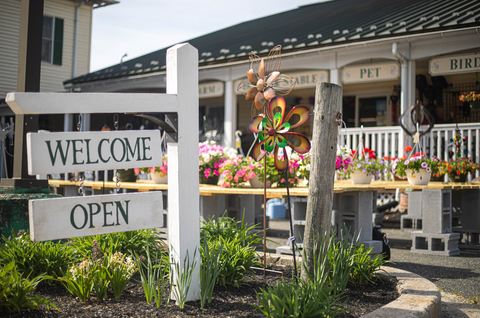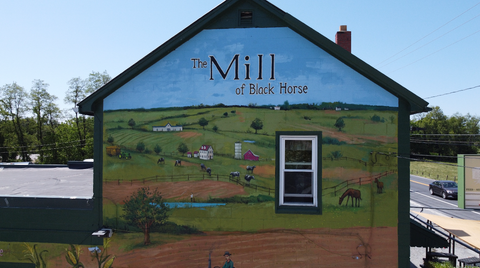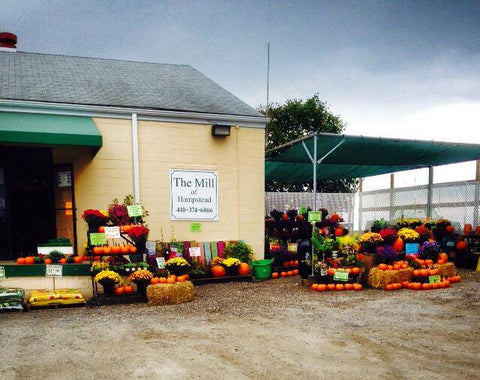A Mediterranean-style garden evokes a sense of tranquility, timeless beauty, and charm with its warm hues, lush greenery, and rustic textures. While the Mid-Atlantic region’s climate may not perfectly replicate the Mediterranean’s dry summers and mild winters, you can still create a Mediterranean-inspired garden with thoughtful plant selection, design elements, and landscaping techniques. With the USDA Plant Hardiness Zone changes affecting our region and hotter, drier summers, the hardy plants found in a Mediterranean climate can find more uses in our area. In addition to drought and disease resistance, they support pollinators, some have culinary benefits and many are fragrant.
Here’s how to craft your own Mediterranean oasis, tailored to USDA zones 6b to 8.
1. Choosing the Right Plants
Mediterranean gardens are defined by hardy, drought-tolerant plants that thrive in well-drained soil and full sun. Fortunately, many Mediterranean plants can adapt to the Mid-Atlantic climate with a bit of care.
Signature Mediterranean Plants:
-
Lavender (Lavandula spp.): A hallmark of Mediterranean gardens, lavender thrives in well-drained soil and full sun. Consider cold-hardy varieties like Lavandula angustifolia for zone 6b.

-
Rosemary (Rosmarinus officinalis): This fragrant herb doubles as an ornamental shrub. In colder zones, grow it in pots and bring it indoors during winter.
-
Olive Trees (Olea europaea): Choose cold-hardy varieties or substitute with ornamental Russian olive (Elaeagnus angustifolia) for a similar aesthetic. Small potted olive trees can be brought inside to overwinter.
-
Italian Cypress (Cupressus sempervirens): These slender, columnar trees provide vertical interest and may be suited for zones 7 and 8 but would need a sheltered location in zone 6b.
-
Sedums and Succulents: Low-growing sedums like Sedum spectabile mimic the drought-tolerant look of Mediterranean succulents.
Traditional Mediterranean Plants and Ideal Zones:
Lavender (Lavandula spp.):
-
Best Zones: 5-9 (depends on variety)
-
Cold-hardy varieties like Lavandula angustifolia thrive in lower zones with well-drained soil.
Rosemary (Rosmarinus officinalis): 
-
Best Zones: 7-10
-
In colder zones, grow it in pots and overwinter indoors.
Olive Trees (Olea europaea):
-
Best Zones: 8-11
-
For zones 6-7, consider cold-hardy varieties like Arbequina or grow dwarf varieties. Since olive trees are very slow growing, a small potted tree can be moved inside for the winter.
Mid-Atlantic Substitutes:
-
Redbuds (Cercis canadensis): Their sculptural form and spring blooms provide a Mediterranean feel.
-
Boxwoods (Buxus spp.): These evergreen shrubs offer structure and can be shaped into formal hedges or topiaries.
-
Perovskia (Russian Sage): Its silvery foliage and lavender-blue blooms resemble Mediterranean flora.
- ‘Taylor’ Juniper (Juniperus virginiana ‘Taylor’) has a strikingly narrow form, making it perfect for mimicking the tall, slender look of Mediterranean landscapes. It's cold-hardy and needs little maintenance making it a good substitute for Italian Cypress in Zones 6 and 7).
- Emerald Green Arborvitae (Thuja occidentalis ‘Smaragd’) while shorter than an Italian Cypress, its rich green foliage and uniform shape work well in Mediterranean-style gardens. It’s also commonly used for formal hedges.
2. Incorporating Design Elements
The design of a Mediterranean garden relies on a blend of natural and architectural elements to create a harmonious and inviting space. 
Stone and Gravel:
-
Use natural stone for pathways, patios, or retaining walls to create an authentic look.
-
Replace traditional mulch with gravel to enhance drainage and mimic the arid feel of Mediterranean landscapes.
Terracotta and Clay:
-
Incorporate terracotta pots for container gardening.
-
Use clay tiles or mosaics to add texture and color to hardscapes.
Water Features:
-
Add a small fountain or reflecting pool as a focal point. Opt for simple designs that emphasize soothing sounds and visual calm.
Seating Areas:
-
Create intimate seating areas with rustic wooden benches, wrought iron furniture, or built-in stone seating.
-
Add shade structures like pergolas or arbors draped with vines such as grapevines (Vitis spp.), mandevilla, clematis, trumpet vine or climbing roses.
3. Soil and Drainage Preparation
Mediterranean plants prefer well-drained soil, which may require amendments in the Mid-Atlantic’s clay-heavy ground.
Tips for Soil Improvement:
-
Mix coarse sand or fine gravel into the planting beds to improve drainage.
-
Add organic matter like compost to enhance soil fertility without making it overly rich.
4. Managing Climate Challenges
The Mid-Atlantic climate presents some challenges, such as humidity, heavier rainfall, and colder winters in zone 6b. 
Winter Protection:
-
Mulch around the base of tender plants to insulate their roots.
-
Use frost blankets or burlap to protect shrubs during extreme cold.
Handling Rainfall:
-
Ensure proper grading to prevent waterlogging.
-
Install drainage solutions like French drains or rain gardens to manage excess water.
5. Seasonal Maintenance
Mediterranean gardens are low-maintenance but not maintenance-free. Regular care will ensure your garden stays lush and inviting.
Key Tasks:
-
Prune plants like lavender and rosemary to maintain their shape and encourage growth.
-
Deadhead flowering plants to prolong blooms. Feed blooming plants with a low nitrogen, high phosphorus and potassium fertilizer every few weeks during the blooming season.
-
Monitor for pests, such as Japanese beetles, which can damage plants in the Mid-Atlantic region.
-
Refresh gravel or mulch annually to maintain the garden’s appearance.
6. Adding Finishing Touches 
Bring the essence of the Mediterranean to your garden with thoughtful accents:
-
Decorative Elements: Add urns, sculptures, or garden lanterns. Statuary and benches provide
-
Color Palette: Incorporate warm tones like terracotta, ochre, and sun-bleached white in your furniture, pots, and accessories.
-
Aromatic Plants: Include fragrant herbs like thyme, oregano, and sage near seating areas for an immersive sensory experience.
Designing a Mediterranean-style garden in the Mid-Atlantic is entirely achievable with careful planning and plant selection. By blending hardy plants, rustic hardscaping, and climate-adaptive techniques, you can create a space that exudes the relaxed elegance of the Mediterranean while thriving in zones 6b to 8. Embrace the charm and let your garden transport you to a sunlit villa each time you step outside!
























